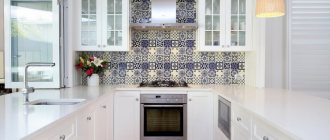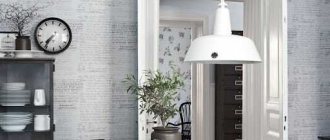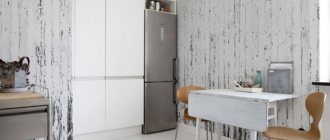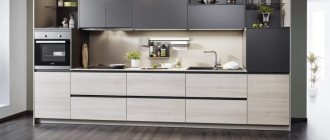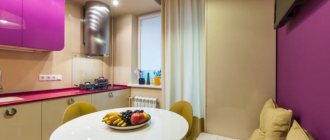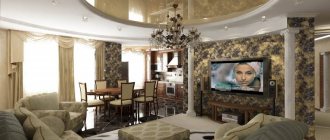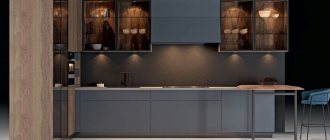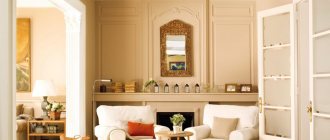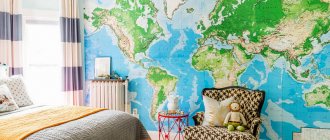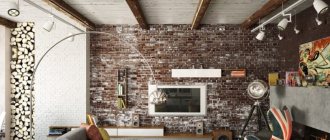Photo: remontt.net Wallpaper can rightfully be called the most affordable way to decorate walls in the kitchen. Today their variety is so great that it is often very difficult for a person without experience in interior design to make the right choice. And if you are faced with the same problem, don’t despair! In our article you will learn many interesting tips on how to choose wallpaper for the kitchen, and the accompanying photographs will provide clear examples. Get inspired!
Types of wallpaper
When choosing wallpaper for the kitchen, take into account the peculiarities of the “local” climate. Since food preparation processes are often in full swing here, the room experiences high humidity and temperature changes. Even the most careful preparation of your favorite dish can affect the wallpaper in the form of splashes of grease or other troubles.
You'll need to clean your walls quite often, so try to choose moisture-resistant wallpaper that can withstand daily cleaning. The markings that the manufacturer applies to each roll will help determine the practicality of the material.
Non-woven wallpaper for the kitchen
Non-woven wallpaper is one of the inexpensive types of finishing, which at the same time can meet all the necessary requirements. More often, wallpapers with a relief pattern are produced, designed for painting. This is very convenient, as you can easily change the kitchen design at any time. You can choose the type of material with a pattern, just pay attention to its practical properties.
Vinyl wallpaper for the kitchen
The main advantage of vinyl wallpaper is its amazing durability. The top vinyl layer allows thorough friction without damaging the structure. In addition, the canvases have a wide range, including models that imitate leather or wood. By the way, if the walls in your kitchen have unevenness, vinyl wallpaper will perfectly hide this defect.
Glass wallpaper for the kitchen
Wallpaper containing glass fibers has good moisture-resistant, fire-resistant and breathable qualities. Fiberglass wallpaper is designed for painting, and it can withstand up to 15 repaintings.
The material is endowed with a relief structure, which can be both an advantage and a disadvantage. The relief will add originality to the kitchen interior, but will also allow dirt to accumulate. So decide what is more important to you!
Liquid wallpaper for the kitchen
A relatively new type of coating on the finishing materials market. Liquid wallpaper is applied in the same way as decorative plaster, and the end result resembles a fabric covering. This is perhaps the most dense material that allows you to hide even significant surface defects, as well as create various patterns. But not all types of liquid wallpaper are moisture resistant - check this indicator when purchasing.
Cork wallpaper for the kitchen
Of all the types considered, cork wallpaper is the most expensive material, the main value of which lies in its naturalness. Cork wallpaper has a service life of up to 20 years, and can be easily washed with water and any detergent. The canvases are not endowed with a variety of palettes and designs, but they look quite respectable in the interior.
Drawing on wallpaper
Not everyone likes plain wallpaper. Some people prefer to glue wallpaper with a relief or other pattern. Here are some tips when choosing such wallpaper:
- It is better to wallpaper a kitchen with a low ceiling with wallpaper with a vertical or diagonal pattern. This option will significantly increase the height of the ceilings and give the room a larger area.
- If the kitchen furniture is without any bright features, then it is better to choose wallpaper with a wild pattern that will attract all the attention.
- For small kitchen areas, it is better to avoid any pattern on the wallpaper. This will visually make the kitchen even smaller.
- As for the design itself on kitchen wallpaper, it can be very diverse: geometric patterns, animals and plants, birds, hieroglyphs, stripes, and so on.
Interior styles
The right style for the kitchen will set the necessary mood, organize the environment, making it comfortable and functional. Decorating the walls with wallpaper corresponding to one direction or another plays an important role here - they, in fact, create a canvas for further placement of furniture and decor.
Wallpaper for the kitchen in Provence style
Wallpaper in light pastel colors with a textured surface is best suited to a Provence-style kitchen interior. Walls with plant patterns in the form of small leaves and flowers will look good here. You can also consider the option of checkered or striped wallpaper that imitates decorative plaster.
Wallpaper for the kitchen in a classic style
For a kitchen in a classic style, you can choose non-woven or vinyl wallpaper with complex floral patterns, monograms, elegant stripes or simple checks.
An excellent option would be canvases that imitate Venetian plaster or expensive fabric covering. In the dining area you can put up photo wallpapers depicting ancient frescoes and streets of old cities.
Wallpaper for the kitchen in a modern style
Modern interiors are characterized by minimalism in design, which also affects finishing materials. Choose plain wallpaper, or better yet, paint it. To prevent the interior from seeming too boring, play with textures. One of the walls can be decorated with photo wallpapers depicting city panoramas or abstractions.
Wallpaper for a Scandinavian-style kitchen
For a Scandinavian kitchen interior, wallpaper in white or soft gray is preferred. It is possible to introduce a pastel group of tones, but not as a dominant one.
If you want to liven up your interior, choose wallpaper with geometric patterns, floral motifs or stripes in blue, gray tones on a light background. The kitchen can be decorated with fragments of walls imitating brick, wood or floral patterns.
Wallpaper for a loft style kitchen
Loft is one of the most unpredictable styles, where untreated surfaces or their imitation dominate. So, a profitable solution for a loft kitchen would be wallpaper to resemble a brick or concrete surface. With such canvases you can decorate one of the walls, while all the others will create an excellent background from simple wallpaper in gray, brown or black.
Classification of wallpaper by functionality
All types of wallpaper are divided depending on their purpose. Some types are designed to be dyed, others are classified as washable.
For painting
Some of this group require a final coat of paint after installation on the base. They are made from various types of raw materials such as paper, non-woven fabric, glass fiber or synthetic particles. The main market share is occupied by dyed non-woven wallpaper.
Available in large size rolls (1 m by 25 cm), suitable for 5-10 repaintings. The base varnish is white.
Subsequent coating properties depend on the type and quality of paint used. The main thing is not to skimp on the composition, as this can worsen the appearance and performance characteristics of the wallpaper.
Washable
Washable wallpaper can be used to cover walls and kitchen furniture. It is intended for use in wet conditions only. The wallpaper consists of rubberized vinyl, which is very dense and has good dirt- and water-resistant properties.
Wallpaper can be installed above countertops, where there is often steam and high temperatures. But it is not recommended to use washable wallpaper for walls in other rooms. Due to its large thickness, it looks rough, and regular washing prevents free air circulation.
Kitchen wallpaper color
The right choice of color plays an important role in kitchen design. Rely on your own preferences, because you will be spending a significant part of your time here. Also take into account the size of the room - a small kitchen in dark colors can turn into a real “kennel”, while a large one in too light colors will become cold and uncomfortable.
White wallpaper
Decorating a kitchen in white is often used when you need to visually increase the area. The palette fills the room with light and lightness, symbolizing cleanliness and order. To remove excessive “sterility”, use different textures and shades.
Beige wallpaper
Beige wallpaper in the kitchen will create a comfortable, cozy atmosphere and will be an excellent backdrop for both light-colored and dark-colored furniture. This palette, unlike bright colors, never bores the eye and is suitable for any size room, you just have to choose the right shade.
Green wallpaper
The use of green wallpaper in the kitchen interior has an individual advantage - such a finish has a calming effect on the human psyche and perfectly whets the appetite.
The color green has about 100 shades, so you can easily choose the one that suits you best. To create a calm atmosphere, soft light colors are suitable, and if you lack drive, use bright, rich colors.
Orange wallpaper
Cheerful orange wallpaper will create a positive atmosphere in your kitchen, conducive to a good mood and excellent appetite. It is also worth noting that the orange palette significantly brightens the interior, enhancing the effect of lighting fixtures.
Black wallpaper
If you have a fairly spacious kitchen and you decide to decorate it with black wallpaper, take care of purchasing a white kitchen set and bright lighting.
Often black wallpaper is used to decorate one of the walls, making an accent and adjusting the space. Give preference to canvases with unobtrusive patterns in white and gray tones, which will add a revitalizing touch.
How to choose wallpaper for the living room: 85 ideas (photos)
Bottom line
The first step is the mental design of the future kitchen-living room ensemble. Then, if we are not talking about a studio and an already combined room, it is necessary to register the redevelopment with a government agency to prevent problems in the future.
It's worth taking the time to explore different interior styles. For first positions in the period 2022-2025. A modern style is emerging, simplicity, geometric lines, minimalism are important here. A maximum of the spirit of freedom and light, and a minimum of voluminous, heavy decor.
Basic colors are preferred - white, gray, black, but bright accents are welcome. Monochrome is allowed, the main thing is not to “eat up” the space and not create a heavy color atmosphere.
Wallpaper material plays a significant role in decorating the walls of the kitchen and dining room. The difficulty lies in the multifunctionality of the room, where they train culinary skills and have cozy conversations over a cup of tea.
Wallpaper in the kitchen and living room must be resistant to both mechanical damage and moisture. This takes into account the main activities of the residents, the presence of small children and animals. It makes no sense to consider metal wallpaper in a house where there are inquisitive kids and active pets.
The color scheme should please and organize the entire kitchen-living room ensemble. Harmony is important in the interior; one part of the room flows smoothly from the other, making up a single whole.
If the furniture is in calm, light colors, you can brighten up the wallpaper, not forgetting about the same tonality. If you have a light, non-garish wall decoration, you shouldn’t choose bright colors for furniture; there’s a danger of joining the circus. It is better to place bright accents - chair upholstery, lampshade, painting, flower pot, decorative pillows, rug, dishes.
And it is wrong to underestimate lighting. Correctly placed lighting elements can completely change the atmosphere, making it more work-bright, festive, colorful, romantic and intimate. Simply by placing lamps of different brightnesses, the area will be visually divided, where the kitchen with a work surface is bright, where the living room is subdued.
Having studied the photos with various options for kitchen layout, wallpaper and color combinations, you will definitely come to an understanding of what you would like to implement in your home.
Pattern and wallpaper design
The most trendy materials today are wallpapers that imitate wooden boards, brick, patchwork tiles, as well as canvases in Scandinavian motifs with geometric patterns, images of leaves, trees, made in light colors. Floral motifs inherent in ethnic and classical trends do not lose their relevance.
Try not to overload the interior with patterns. Make one accent wall colorful and the rest monochromatic. Neutral beige, white or gray wallpaper will look great against the background of abstract designs, ornaments and textured coatings.
Don't forget that the placement of patterns can affect the visual perception of the kitchen! Vertical strokes will “raise” the ceiling, and horizontal strokes will expand the walls. Diagonal patterns on the walls will add more life dynamics to a bored space.
Cons of using a white kitchen
It will not do without a small fly in the ointment. A white kitchen also has some disadvantages that you need to remember:
- poor-quality factory painting of the headset can cause yellowing;
- impracticality: because The kitchen is a room that is actively used by all family members; cooking is often done here; keeping the white color in perfect condition is not so easy.
Photo wallpaper in the kitchen interior
Wallpaper with photographs is an excellent decorative element of decoration. The main thing is to choose the right picture that will match the style of the kitchen. Today, manufacturers offer a huge selection of ready-made photo wallpapers, the size of which you can adjust to suit your measurements. Some people order canvases with photos from their personal archive, reminiscent of the best moments of life.
Photo wallpapers are often used to decorate the area near the dining table. These can be landscapes, images of flowers, fruits, panoramas of megacities or ancient streets. By covering one of the walls with wallpaper with a perspective, you can significantly increase the space of your kitchen at the visual level.
Wallpaper for the hallway: 80 photos and beautiful solutions
White kitchen. Design tips
- First you need to decide on the type of facade - gloss or matte. The first option will be more practical in terms of cleaning, but hand marks will be almost invisible on the matte finish.
- Designers advise using granite or marble countertops and wooden facades for a white kitchen. The white set pairs perfectly with stainless steel, polished nickel and glass elements.
- To prevent the kitchen from becoming faceless, it is necessary to introduce color accents into the interior. Both muted and bright shades can be used. It is better to finish the walls with plaster or washable wallpaper.
- Open shelves will look much more attractive than wall cabinets. It is more profitable to use ceramic tiles on the floor, which are easy to clean. The checkerboard pattern is considered the most advantageous. White laminate and wooden boards of different shades will look attractive on the floor.
Correct combination of wallpaper
Combining wallpaper allows you to highlight certain functional areas, making the kitchen interior more unique and original. When choosing a material, try to choose wallpaper with the same density that matches each other in patterns or color palette.
You can combine wallpaper vertically or horizontally, thereby adjusting the space. An accent wall with patterns will look impressive against the background of other plain coverings.
Take note that you cannot combine two patterns that are different in style (for example, floral prints with geometric shapes). The same applies to the use of more than three types of patterns and textures in the interior. If you wallpaper your kitchen with different wallpapers like flowers, checks and polka dots, you will get a real pun.
Fashionable style solutions
Among the various interior styles, the most popular are Scandinavian and minimalist styles.
Classic
If you are planning a classic interior, choose wallpaper with stripes, checkered patterns, floral or coffee wallpaper, or wallpaper with a floral motif.
Pastel or dark colors suit this style. Wallpaper that imitates historical frescoes, borders or architectural structures will also be a good decoration.
Loft
Can be plain or multi-colored, textured or smooth. Different types of wallpaper are acceptable, but it is better to purchase companion wallpaper of identical composition and texture, which is easy to wash and glue.
Wallpaper for the kitchen in a modern style
If you see a design that is neat and tidy, then it is most likely modern. For a modern kitchen interior, wallpaper should be plain and muted colors, such as white, grey, black, beige or light blue.
Also acceptable are photo wallpapers, discreet monochrome designs, alternating glossy and matte textures, polished stone, wood effect, and metallic shine.
Minimalism
Minimalism is still at the peak of popularity. His motto: “Nothing superfluous.” Minimum accessories and maximum functionality. Its colors are white, gray and black. This is diluted with bright accents and carefully thought out lighting. Ceilings in kitchens are often multi-level, adding creativity to the room.
Japanese style
In Japanese cuisine, this is a place of relaxation, rest for body and soul.
To create a relaxing and calm interior, it is best to use natural colors such as ocher and green. Wallpaper with an imitation bamboo wall or a wall fresco with ethnic motifs and calligraphy, drawings with exotic flowers and birds will enliven your kitchen.
You can choose a design in the spirit of Japanese minimalism, or you can give preference to bright colors by choosing wallpaper that contrasts with the furniture.
Country
Wallpaper with floral prints, vegetables, fruits and berries fit harmoniously into this style. It is better to choose natural shades (wheat, green, olive, beige).
Provence
Colorful designs require bright and light colors. In such a room you can use canvases with floral prints and natural accents (tree branches and leaves, images of insects, etc.).
Modern
Shades of romanticism, classics, retro and other styles are possible. Asymmetrical graphics, waves and flowing lines are used to create accents that can be combined with sleek wallpaper. Ideal for modern times are options with imitation of natural finishes, such as brick or masonry stone, leather.
High tech
He suggests using a bright palette, laconic lines and the absence of excessive luxury. Wallpaper with unobtrusive relief, discreet design and imitation of aged plaster, tiles or concrete soil are suitable for interiors.
Wallpaper for a Scandinavian-style kitchen
The cool freshness of Scandinavian design is guaranteed by walls whose colors and textures are reminiscent of the winter landscapes of Norway, Sweden or Denmark. It can be the sparkling purity of virgin snow, the mysterious depths of lakes and rivers, the smoky airiness of the sky, the mystical glow of the sunset.
Add a warm note to your kitchen with bleached oak textures, wool knits and deep red ethnic patterns on a linen background.
How to choose wallpaper for a small kitchen
It's no secret that light walls can visually increase the dimensions of a small space. Use this solution for your small kitchen and choose wallpaper in white, milky or light gray tones. You can also use light pastel shades if the kitchen faces south and does not lack sunlight.
If you don’t like a monochromatic design, cover the walls with light wallpaper with small patterns, and it is better to avoid large patterns and ornaments. If your kitchen is not only small, but also narrow, you can use a design technique - paste short walls with light-colored canvases, and long walls with darker ones. As a result, you will get a modern, stylish interior!
What to look for when purchasing
Follow our recommendations if you don't want to buy low quality wallpaper:
- First of all, remember that good building materials are rarely cheap. See what online stores offer and read our article where we list good brands. Have you been offered something much cheaper? There is a chance that the wallpaper will fall off in the first month or the colors will lose their brightness.
- Do not buy wallpaper at bazaars or dubious stores. Storage conditions are not always met, so you risk purchasing a soggy product.
- Measure carefully before purchasing and make sure you have a roll to spare. No matter how carefully you apply wallpaper, there is always a risk that you will damage something in the process.
- Have you decided to buy embossed wallpaper? Carefully inspect each roll: scuffs and scratches may appear not only during operation, but also due to manufacturing defects. Replacing such a roll will not be easy.
- Please read the technical specifications carefully. Not every coating is suitable for use in the kitchen.
Choosing wallpaper for the kitchen-living room
The kitchen-living room is a vast area where you can fantasize “to the fullest.” Since the room will have several functional zones at once, wallpaper can act as a determinant of a particular area.
Choose moisture-resistant, washable wallpaper for your kitchen. The cooking area is often decorated with plain wallpaper or imitating brickwork or wall tiles. For the walls of the living room, choose more spectacular “clothes”. Don’t skimp on the material – everything here should look quite rich, even plain wallpaper.
The highlight of the interior can be natural wallpaper - fabric, bamboo or cork coverings are sure to attract the attention of guests. In the living room, you can decorate an accent wall in the area of the TV or sofa. For this, use brighter canvases, large drawings, photo wallpapers or original combinations of materials.
Interior design of a small kitchen (90 photos)
Tips for selection and care
- It is not recommended to glue any wallpaper in the kitchen work area for obvious reasons - regular contact with water, proximity to the stove, constant contamination with grease and food particles. Even the most expensive, high-quality material will not withstand such conditions. Exception: wallpaper covered with glass in the apron area.
Under glass
- Perfectly smooth walls are the best basis for any wallpaper. Despite manufacturers' promises to level the walls after gluing, it is still worth preparing the base. Even the densest ones will not hide strong changes, slopes, or large bumps.
- Carefully read the instructions for the material and glue if you decide to hang wallpaper yourself, but do not have professional knowledge and skills in this matter. What matters is the selection of a special glue for a particular material, the proportions in which the solution must be diluted, as well as the technology for its application.
Watch a useful video on choosing materials for the kitchen:
Wallpaper for the kitchen - photos and ideas
To conclude the review, we invite you to visit our photo gallery. Here you will find many interesting solutions for kitchen design with wallpaper and be sure to choose the most suitable option for your interior!
Wallpaper care
In order for the new decoration and design of the kitchen to satisfy the hostess for a long time, it is necessary to maintain cleanliness. You should also follow the instructions for working with wallpaper in the kitchen. First of all, remember not to brush your wallpaper too often, because even the hardest, most durable washable wallpaper will become damaged from frequent use.
If a stain occurs, it should be wiped off immediately with a damp sponge. If you remove dirt in a timely manner, it will not remain on the wallpaper for long.
Do not use laundry detergent as a detergent. When choosing a detergent, test it first. To do this, add detergent to water, lather, clean a small area of wallpaper and leave for a while. If the surface has not changed, you can safely use a cleaning agent.
If the surface is heavily soiled, has stubborn stains or heavy dirt, most likely removing the dirt the first time will not give the desired effect. The procedure may need to be repeated after the wallpaper has had time to dry.
How to keep it clean
Owners of a white kitchen are often interested in the question of why the sparkling surface turns yellowish over time. The main enemy of the headset is sunlight! That is why immediately hang blinds or curtains in the kitchen.
The main rule for keeping the kitchen in its original form is express cleaning. It involves timely cleaning of surfaces immediately after cooking. Fresh stains can be easily removed with napkins.
Turn on the hood as soon as you start cooking. So, you can filter out the smallest particles settling in a white kitchen.
Clean the set every month with dishwashing liquid and warm water. At the end, be sure to wipe all surfaces dry. The tiles and the seams between them can be easily cleaned with a paste of soda and vinegar.
If the kitchen begins to turn yellow, prepare a mixture of a glass of vinegar and a spoonful of soda with two glasses of warm water.
How to complement the color
Ripe fruits on the table or a vase with a bouquet of flowers will look great in a white kitchen. A brightly colored stove or refrigerator would be a great addition.
Gold-plated fittings, a chandelier and other accessories will perfectly highlight accents in the kitchen and emphasize the beauty of the set.
The material for lighting fixtures can be bronze or chrome-plated metal. Wooden elements look quite expensive and will make the decor stylish and aristocratic.
If pure white seems too “operational”, you should take a closer look at shades of ivory, pearl and cream.
An accent in a white kitchen can be an original window design with expressive Roman blinds or curtains with floral motifs. A ceramic apron with a bright frame will look very beautiful.
You can liven up the interior of a white kitchen with compositions of greenery. Flower pots look very elegant against the backdrop of glossy facades. It is worth remembering that fresh flowers should not destroy the holistic perception of the interior.
Scandinavian classic
A white kitchen is a typical design solution for the Scandinavian style. Often a mixture of cool grays, blues, indigo or dusty pinks is added to this style direction.
Another typical feature of the Scandinavian interior is natural materials, so wood is almost always chosen as the material for the countertop.
Open rails, slate boards, and various jars for storing food can also be called typical Scandinavian decor.
Combined wallpaper: a practical design solution
Using this decorative technique helps solve several interior problems at once:
- zone the space;
- visually add light to the room;
- visually increase ceilings and expand walls;
- disguise design flaws.
To choose the right wallpaper and radically transform the interior, you need to consider the following points:
- Wallpaper must match the overall style of the interior;
- Try to select wallpaper of the same quality and same price category;
- Make sure that the wallpaper is of equal thickness;
- Alternate bright designs with monochromatic colors, balance saturated colors with calmer ones;
- An abstract pattern will go well with a geometric one, wood textures will go well with floral patterns.
Material selection
Let's imagine that you have already arrived at the store, and there are hundreds of different rolls. Wide and narrow, white and colored, with prints and monochrome. They are all different, and it’s difficult to understand right away what you want.
Let's start with the main thing. Before choosing a color scheme and width, you need to decide on the material.
There are several main types of wallpaper:
- paper;
- vinyl;
- non-woven;
- textile;
- fiberglass.
Each option is good in its own way. To understand what exactly you need, consider the characteristics of each type. And this is a small summary of the marking icons that you can find on wallpaper. This will be 100% useful to you.
Paper
The simplest, most common and budget finishing option. Ideal for any premises where it is important to update the interior and create an environmentally friendly atmosphere.
There are two types of paper wallpaper:
- Simplex - single-layer materials of low density and strength. They are thin and will not hide defects, so the walls must be thoroughly leveled before gluing.
- Duplex - two-layer coatings where layers of paper are glued to each other. Ornaments, prints or embossed patterns are applied to the front surface. Duplex is stronger and more durable than simplex, but costs more.
And now - about the pros and cons of paper wallpaper.
| pros | Minuses |
| Eco-friendly | Not suitable for wet areas |
| “Breathable” | Sensitive to mechanical damage (especially simplex) |
| Do not cause allergies | Fade quickly, fire hazard |
| Moisture and vapor permeable | Absorbs odors and fat |
| Budget | When gluing, problems arise (especially with simplex): the paper quickly gets wet and becomes unstable. This complicates the joining of the canvases and the adjustment of the pattern. |
| Large selection of colors, prints and patterns | Short-lived (simplex is replaced every 2-3 years, duplex - every 4-5 years) |
Note! Paper wallpaper is used where economical, quick repairs are needed. Or the environmental friendliness of the finish comes first. But, in any case, it is better to choose a duplex rather than buy a cheap simplex.
Vinyl
Vinyl is a popular wallpaper material for kitchen walls. The structure of vinyl sheets is multilayer. It consists of a paper or non-woven backing coated with a layer of vinyl (PVC) of a certain color, texture and density. According to the production method, external indicators and price, products are divided into three large groups:
- voluminous, with a beautiful and embossed decorative coating;
- super washable (recommended for kitchens!);
- silk-screened, with a beautiful pattern made of vinyl and silk threads.
| pros | Minuses |
| Embossed, dense and durable | “Breathe” worse than paper ones |
| Resistant to fading and abrasion | |
| Moisture resistant, can be wiped with a damp sponge | Poorly permeable to moisture and steam |
| Hides minor defects in wall decoration | |
| Large selection of colors and types | To do a good job of gluing, you need experience. |
| Will last at least 10-12 years | |
| With smooth walls and high-quality gluing, you will get a solid, seamless canvas | They are more expensive, especially in comparison with paper counterparts |
Vinyl coatings “breathe” less well and are less permeable to moisture and steam than paper ones. But do not be afraid that moisture and mold will accumulate under them. This can only happen in two cases. If:
- the apartment was flooded, and this happened during the cold season;
- a dark room with constant humidity and poor ventilation gets wet;
- The apartment is unheated, non-residential.
Note! The walls will become moldy if it was not possible to immediately ventilate and warm up the flooded home. In other cases there are no problems with vinyl trim.
Non-woven
Wallpapers from this line are safe and beautiful. Tear-resistant and abrasion-resistant. There are two main types:
- On a non-woven base, covered on the front side with a decorative layer of paper, vinyl, textile, or any other material;
- Non-woven on both sides. Moreover, the front layer is often textured and embossed.
| pros | Minuses |
| “Breathable”, moisture resistant; do not absorb dirt and dust; considered hypoallergenic | More expensive than paper counterparts |
| They can be washed or wiped with a damp cloth. | The convex, textured layer is easily damaged. |
| A thick layer of base hides minor defects and cracks in the walls. | Cheap options are of low quality and may contain toxic substances that are dangerous to humans. |
Non-woven materials are easy to work with. When gluing, glue is saved, because it is applied only to the wall. After drying, the material does not shrink. If glued correctly, seams and joints will not be visible.
Interesting fact! Non-woven wallpaper on a non-woven basis is the best choice if you want to change the decor of the kitchen, but not undertake a major renovation. After all, such coatings can be painted, changing color up to 8-10 times.
Textile
They are considered the most exquisite and decorative. They are expensive, but they also look expensive. After renovation they look like a luxurious carpet in the interior. The basis of finishing materials can be non-woven or paper. A layer of textiles is applied on top: linen, silk, viscose, threads of natural and synthetic origin. Or veneer, jute, seaweed, bamboo, cork, reed.
| pros | Minuses |
| Eco-friendly | Not suitable for the kitchen (!) |
| Pleasant to the touch | Narrow range of colors and textures |
| Exclusive, expensive looking | Short-lived, quickly fade in the sun |
| Holds heat well and protects from noise | To protect against dust, special impregnations are needed |
| Perfectly masks small cracks and uneven walls | They are expensive, and the work will cost a pretty penny, since gluing is more difficult (that’s why they are often used to finish one wall) |
Important point! Textile materials are difficult to care for. It is not recommended to remove dust and dirt with a wet cloth. It is best to collect it all with a long-bristled brush or vacuum cleaner. Wet cleaning is only permissible for coatings with water-repellent impregnations.
Glass wallpaper
Fiberglass, or fiberglass, wallpaper is made from glass fibers of different densities and thicknesses. The fibers are woven into fabric using the weaving method, and then impregnated with starch additives. Then the relief surface can be painted with latex or any other water-based paint.
| pros | Minuses |
| Eco-friendly | Narrow selection of colors and patterns |
| Strong, durable and moisture resistant | Porous, actively absorb paint when painted |
| Wear-resistant, does not absorb odors and fats | Once pasted, it will be very difficult to remove |
| Well masks uneven walls | You need to glue it on a perfectly flat plane, otherwise after drying the finishing material will become covered with cracks. |
Fiberglass is very durable, wear-resistant and reliable. This wallpaper is best suited for offices, banks, hospitals and hotels. But they can also be chosen for the kitchen. The surfaces will withstand up to 10-12 repaintings and last up to 28-30 years.
Important point! Fiberglass is considered practical and absolutely harmless. Designed for constant and active use. They are recognized as the most fireproof; upon contact with fire they do not release toxins.

